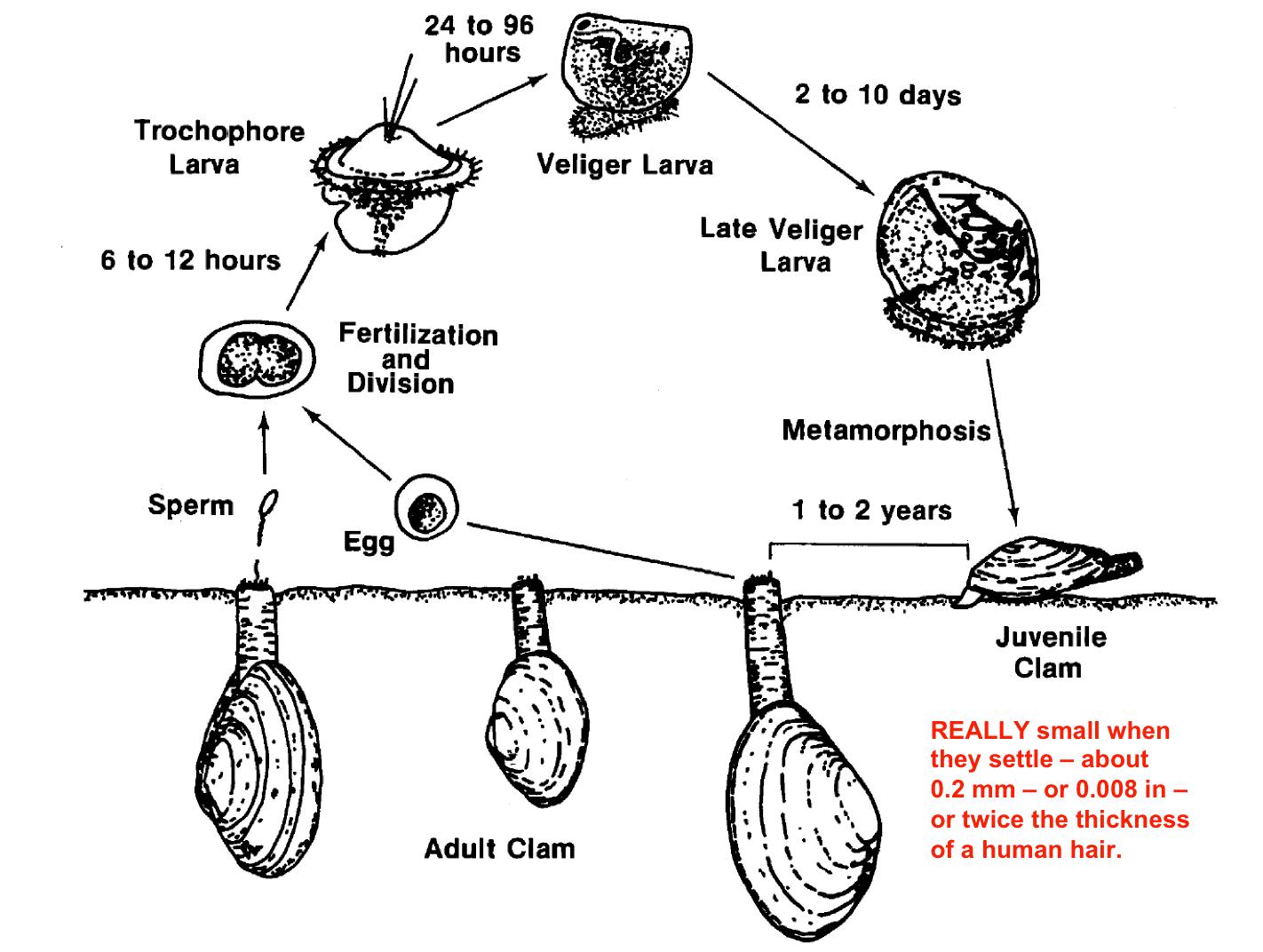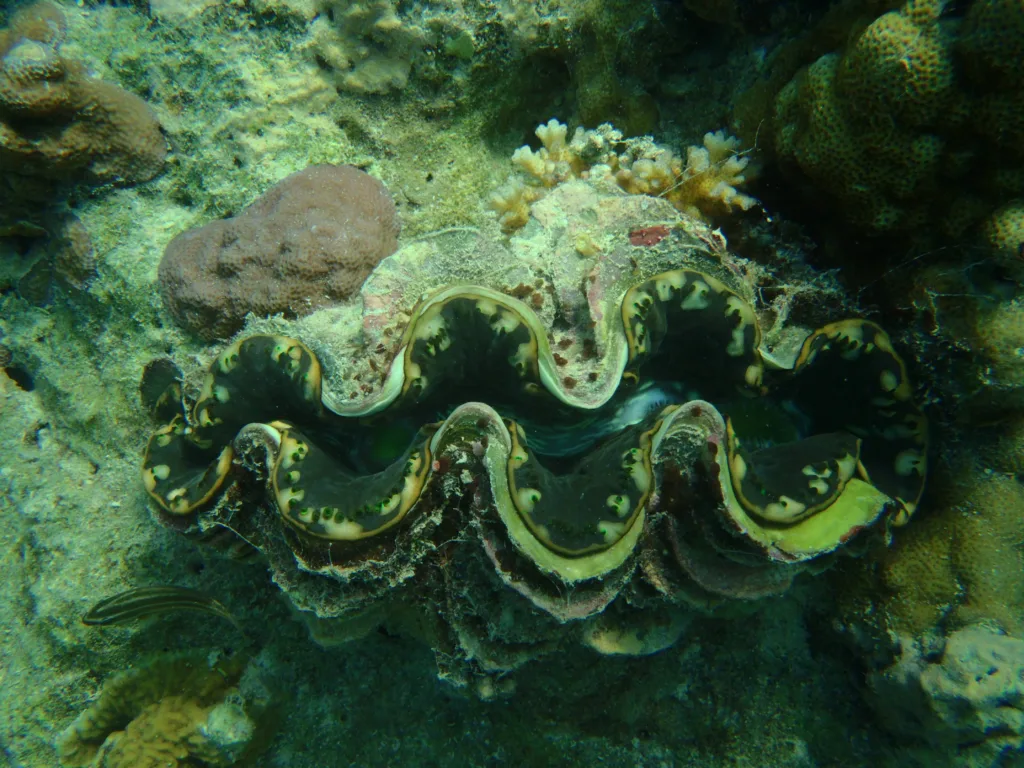Clams are fascinating creatures that reproduce seasonally by releasing eggs and sperm into the water. This occurs generally in mid-summer when the water is warm and planktonic food is abundant. After fertilization of an egg, cellular division produces larvae, and eventually tiny clams that settle to the bottom. It is important to note that clams are not born with shells. They are free-swimming larvae after they hatch, and just prior to metamorphosis, they secrete a hard shell.
Females can produce a staggering number of eggs at a time, ranging from one hundred thousand to one million eggs! Softshell clams, for example, can live 10 to 20 years and usually spawn twice a year. This means that a female can potentially generate and release 20 to 40 million eggs in her lifetime! A veritable egg factory, indeed!
It is worth noting that some clams have life cycles of only one year, while at last one has been aged to over 500 years old. All clams have two calcareous shells or valves joined near a hinge with a flexible ligament, and all are filter feeders.
The reproductive process of clams is a fascinating one. These creatures release millions of eggs into the water, which eventually develop into tiny clams that settle to the bottom. With their unique life cycles and filter feeding habits, clams are a vital part of the marine ecosystem.
Giving Birth: How Clams Reproduce
Clams do not give birth in the traditional sense, as they are not mammals. Instead, they reproduce by releasing eggs and sperm into the water, a process known as spawning. This typically occurs seasonally, usually in mid-summer when the water is warm and thre is plenty of planktonic food available.
During spawning, male clams release sperm into the water, which fertilizes the eggs released by female clams. Once fertilized, the eggs develop into larvae through a process of cellular division. These larvae eventually settle to the bottom of the water and transform into tiny clams.
The process of spawning and fertilization is dependent on environmental factors such as water temperature and food availability. Clams require specific conditions for successful reproduction, which is why spawning typically occurs at a specific time of year.
It’s worth noting that not all clam species reproduce in the same way. Some species are hermaphroditic, meaning they have both male and female reproductive organs and can fertilize their own eggs. Others have separate sexes and require a male and female to reproduce.
Clams reproduce by releasing eggs and sperm into the water, which fertilize and develop into larvae that eventually settle to the bottom and become tiny clams. The process is dependent on environmental factors and varies between different clam species.

Source: csi-maine.org
Do Baby Clams Have Shells at Birth?
Clams are mollusks that have a hard shell to protect their soft bodies. However, baby clams are not born with shells. When clams hatch, they are free-swimming larvae that are not yet equipped with a shell.
During their larval stage, clams are microscopic and can float freely in the water for days or even weeks. As they mature, they begin to develop a hard shell to protect themselves from predators and the environment.
Just before metamorphosis, clams secrete a hard shell made of calcium carbonate. This shell provides protection and support throughout their adult life.
It is important to note that different species of clams have different shell structures, sizes, and shapes. Some have smooth shells, while othes have ridges and bumps. The color of their shells can also vary depending on the species and environment they inhabit.
Baby clams are not born with shells. They develop a hard shell just before metamorphosis, which provides protection and support throughout their adult life.
Reproduction Rate of Clams
Clams are a type of bivalve mollusk that reproduce through external fertilization. The reproductive process of clams is characterized by the release of eggs and sperm into the water, where fertilization occurs. The speed at which clams reproduce can vary depending on the species and environmental conditions.
Softshell clams, for example, can live up to 20 years and typically spawn twice a year. During spawning, females can produce anywhere from 100,000 to 1 million eggs at a time. This means that in her lifetime, a female softshell clam has the potential to generate and release 20 to 40 million eggs!
Other clam species, such as the Atlantic surf clam, can reproduce more quickly. These clams can reach sexual maturity in as little as two years and spawn up to six times per year. Females can produce anywhere from 500,000 to 4 million eggs per spawn.
It’s important to note that the reproductive rates of clams can be affected by a variety of environmental factors, such as water temperature, salinity, and nutrient availability. In areas with favorable conditions, clams can reproduce more quickly and abundantly.
The speed at which clams reproduce can vary depending on the species and environmental conditions. Some species, like the softshell clam, can live up to 20 years and typically spawn twice a year, while others, like the Atlantic surf clam, can reach sexual maturity in as little as two years and spawn up to six times per year.
The Life Cycle of a Clam
Clams, like many other mollusks, have complex life cycles that vary depending on the species. Generally, clams start their lives as microscopic larvae that drift in the water column. These larvae eventually settle on the seafloor, where they develop into juvenile clams.
The length of a clam’s life cycle can vary greatly among different species. Some clams, such as the soft-shell clam, have a life cycle that lasts only one year. These clams reach sexual maturity quickly and release their eggs and sperm into the water column, where fertilization occurs. The resulting larvae then settle on the seafloor and repeat the cycle.
Other species of clams have much longer life cycles. The ocean quahog, for example, can live for over 500 years, making it one of the longest-lived animals on Earth. These clams may not reach sexual maturity untl they are several years old, and they only spawn once a year.
Regardless of their life cycle length, all clams share certain characteristics. They have two calcareous shells or valves joined near a hinge with a flexible ligament. They are also filter feeders, meaning they use their gills to filter tiny organisms and particles from the water column.
The life cycle of a clam can be complex and varies depending on the species. While some clams may only live for one year, others can live for centuries. However, all clams have two shells and are filter feeders.

Conclusion
The reproduction of clams is a fascinating process that occurs seasonally when water is warm and food is abundant. Female clams are capable of producing a staggering number of eggs, ranging from one hundred thousand to one million at a time, and can potentially generate and release millions of eggs in their lifetime. Clams do not have shells when they are born, but instead, they develop them just before metamorphosis. While some clams have a lifespan of only one year, oters can live up to 500 years old. Regardless of their lifespan, all clams have two calcareous shells joined near a hinge with a flexible ligament, and are filter feeders. the intricate process of clam reproduction is a testament to the wonders of nature and the diversity of life in our oceans.
